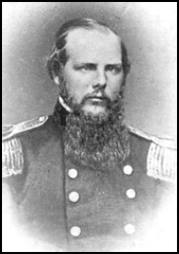Schofield, John
 This future General-in-Chief of the Army was born in New York, moved as a child to Illinois, and graduated from West Point in 1853. In 1860, he took a leave of absence to teach physics at Washington University in St. Louis. His leave ended abruptly in May, 1861, when he offered his services as chief of staff to Gen. Nathaniel Lyon. Schofield was present in this capacity during St. Louis’ Camp Jackson incident on May 10, 1861. He then accompanied Lyon on the campaign that culminated in the Battle of Wilson’s Creek, August 11, 1861. In 1892, Congress would award Schofield a Medal of Honor for his actions at Wilson’s Creek.
This future General-in-Chief of the Army was born in New York, moved as a child to Illinois, and graduated from West Point in 1853. In 1860, he took a leave of absence to teach physics at Washington University in St. Louis. His leave ended abruptly in May, 1861, when he offered his services as chief of staff to Gen. Nathaniel Lyon. Schofield was present in this capacity during St. Louis’ Camp Jackson incident on May 10, 1861. He then accompanied Lyon on the campaign that culminated in the Battle of Wilson’s Creek, August 11, 1861. In 1892, Congress would award Schofield a Medal of Honor for his actions at Wilson’s Creek.
Schofield was promoted to brigadier of volunteers in November, 1861. Much of his service in 1862 and 1863 was in Missouri, and by May, 1863 he rose to the position of Commander of the Department of Missouri. During his tenure in Missouri, he was criticized for heavy-handed policies directed to Southern civilian and partisans. Some blame his general orders for the issuance of the infamous Order Number 11 in August, 1863.
Schofield is most famous as the general who was nearly trapped by Confederate forces in Tennessee, but escaped to deal a death blow to John Bell Hood’s army at Franklin, Tennessee, on November 30, 1864. After the War, he served as Secretary of War, superintendent of West Point, and in 1888 Schofield was promoted to Lt. General and Commander-in-Chief of the U.S. Army. He died in 1906 and is buried at Arlington National Cemetery.

